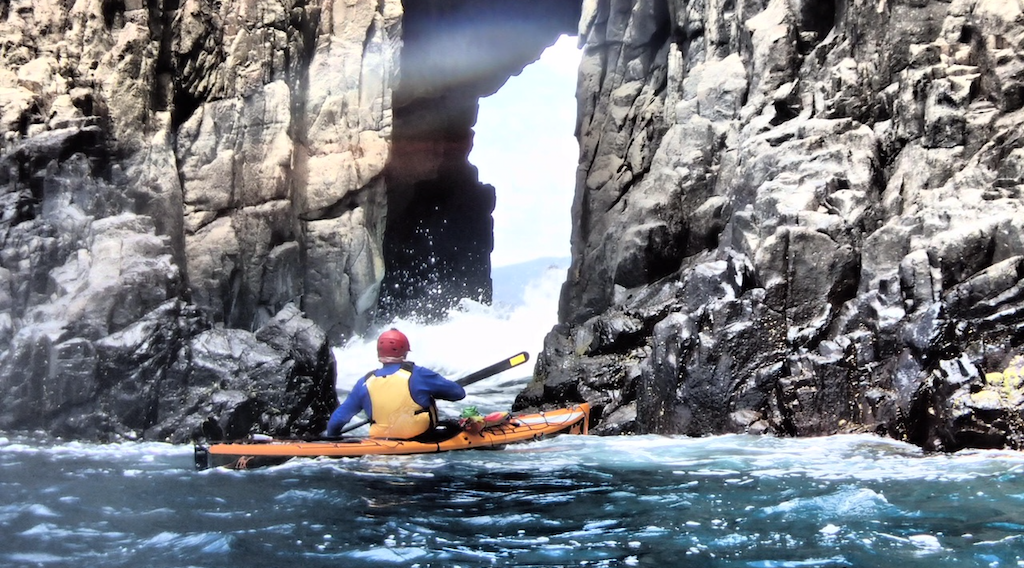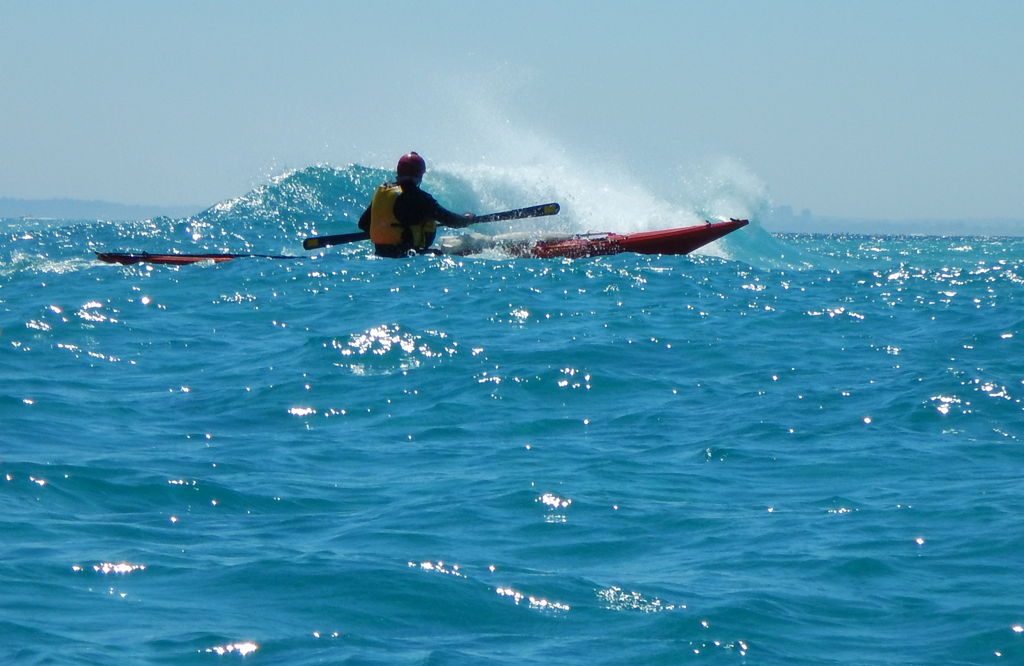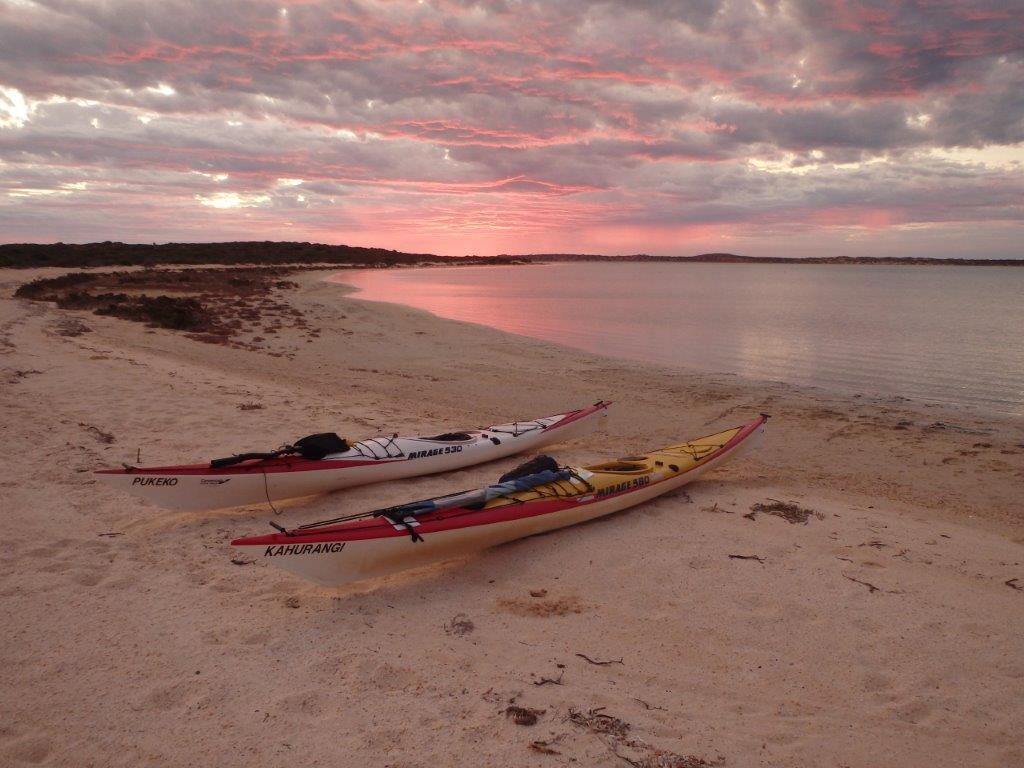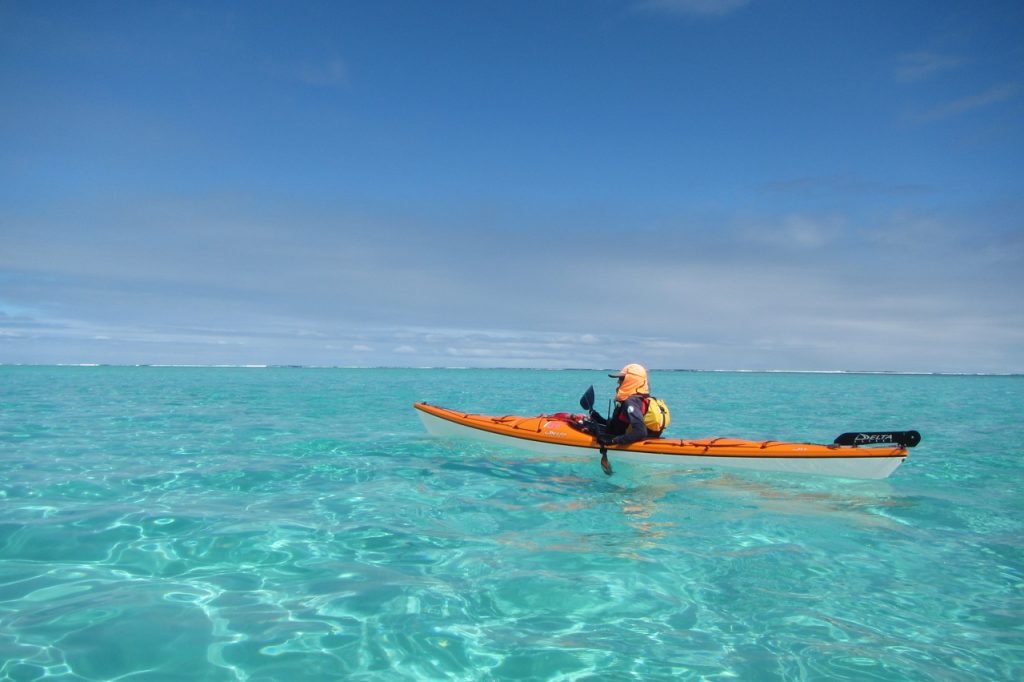By
Adrian Gawned
Across the hemispheres: a paddle from the Northern hemisphere to the South over the Equator. Could that be the next adventure in the Raja Ampat region of West Papua, Indonesia? My visit in 2013 was just an introduction, a taste to whet the appetite, during that trip it was evident the region offered so much more. The desire to paddle further and farther from civilisation was born and planning to paddle the area from Pulau Wayag to Pulau Waigeo began.
Planning was logistically more difficult, a round trip up and back or a one way transfer to Wayag and paddle back. At USD $1300 the cost of the transfer for one person was prohibitive. On advice from Tertius at kayak4conservation, I contacted Matt Edwards of Expedition Engineering. Matt and two others, Rob Falloon from Melbourne and Richard Jolly from Perth decided the trip was worth doing, planning commenced and flights were booked.
We gathered in Sorong on Saturday the 22nd November 2014 where, after some last minute preparations, it was the fast ferry to Waisai, an hour and a half away where we were met by Tertius Kammeyer and transferred to Mando’s homestay in the village of Saporkren for an overnight stay.


Cynically I assumed he was trying to extort more money for the transfer.
By midday another boat was located, crossing from Sorong and arriving mid evening we loaded and left Saporkren about 10:00pm for an overnight voyage to Wayag. I opted to sleep on the foredeck with the crew while my companions chose to sleep on the roof. I drifted off to sleep to the sound of the boats diesel engine.

The morning of the 24th dawned; we were off the coast of Pulau Kawe with Wayag in the distance, the seas mirror like, the dawn spectacular. After entry formalities at Pulau Wayag where more money was demanded of us, we arrived at our destination inside the maze like lagoons.
Unloading the boats we set camp and had lunch. An afternoon paddle through the lagoons ironed out minor issues with boats. With so many beaches an anticipated climb to the peak of one of the mounts for an aerial view was aborted, we couldn’t find the right beach.


The following morning, dawn and a 4:30am wake up, we breakfasted, struck camp and set off through the lagoons of Wayag, taking in the truly amazing scenery this area offers, in search of a route out into the Pacific Ocean on the northern side.
We opted for an exit with a one metre surf break. Our Papuan interpreter/guide, Sony, had never encountered surf before, tethered to Matts craft for safety they hit the surf, paddling hard, Sony’s eyes like saucers, he rapidly overtook Matt and they were out. The rest of us followed.
Breaking out we turned east along the northern coast, walls of limestone rising out of the ocean as a backdrop, the long slow Pacific Ocean swells crashing against the base, we happened upon one of the largest sea arches any of us had encountered.

Turning back into the lagoons we found a small beach for a break before hitting the water again, only to encounter the infamous currents and tides the area is known for, running at about 6 knots with extremely confused seas, we opted to land in dumping waves to wait out the worst of it.
Crossing to Pulau Quoy, which is known for its huge vertical walls of limestone, frigate birds soared overhead. A broken rudder cable saw me pushed rapidly south, a tow was necessary, we beached on Pulau Quoy for the night. The sunset over Wayag was magnificent.

Wednesday the 26th November 2014 we crossed to Pulau Kawe some 20kms distant, with favourable tides we made good time despite soaring temperatures and humidity. I for one sucked in the water to stem dehydration, just under 3 hours later we landed on the north coast of Kawe, Rob tried his hand at trolling enroute “for whales” judging by the size of the lure, without success.
After a break on a small beach exposed to surf which rolled coral boulders and logs at us, we paddled the last kilometres to our overnight camp, a sheltered beach facing west, great sunset and a last view of Wayag.
The evening routine of dinner, prepared by Matt and a small tot of whisky or rum was much anticipated. It was here we learnt there was a water issue; we were running low, no more tea or coffee.
One of our 20 litre bladders had been punctured during the transfer from Saporkren so we were not able to carry as much as we had hoped or needed.
Sunset came and went, darkness descended, with it came the mozzies, the surf crashed endlessly on the beach at night. I fell asleep in my hammock while the others slept in their tents.


Next morning saw us tracking the west coast of Kawe, shortly after launch Rob announced we were about to cross the equator, with a last paddle stroke we slid back into the Southern Hemisphere.
Continuing south we landed at the rear of the now abandoned nickel mine and went in search of “kelapa muda” or green coconuts, their water a good rehydrating fluid. A search by Matt and Rob located the mine’s water source, a trek with the bladders was fruitful, we had water again.
Pressing on along the coast, passing between Kawe and Pulau Balabalek we encountered a school of Manta, sitting motionless in our kayaks as they leapt out of the water and slid noiselessly under us. What a sight!
Rounding the bottom of Kawe we headed to the overnight camp, a freshwater lagoon that smelt of sulphur at the rear of the beach made for a welcome freshwater dip, no crocodiles. The water gathered earlier was treated, hammock and tents put up and dinner prepared before the sunset. Again all the magnificent colours of the spectrum, yellow, blue, pink and purple before darkness came, along with the mozzies. Irritating little creatures buzzing around us so off to bed before they attacked; the rains came at night and in the early morning making it cool enough to cover with a sleeping sheet.
Friday the 28th November dawned to smooth seas and clear skies, the days paddle would take us into an area known as the “crazies” between the SE corner of Kawe and Pulau Seferang a shallow shelf running out from Kawe caused the water to build into confused seas and strong tidal rips. It looked benign as we approached, the tide was turning, between Seferang and Roibe we found it to be running out strongly and we were easily drawn into the channels if caution wasn’t exercised.
We landed on Seferang for a break and a leg stretch, the liveaboard dive boat “Manta Mae” anchored nearby. A completely different type of travel to what we were experiencing and not how I would choose to see this part of the world.


Resuming our paddle we followed the coast of Seferang, crossed to Pulau Roibe a short distance away, paddling amongst the limestone karst islets and mounds before heading SE for the 6km to Pulau Aliyai, from there we would decide a route through the Aliyai or D’Enrecasteaux channels, we chose the D’Entrecasteaux channel where we would have a break before continuing to the village of Selepele.
Stepping out of the kayaks on a small strip of beach inside the D’Entrecasteaux channel we stretched our legs and napped in the shade while the hottest part of the day passed, back in the kayaks we pressed on to Selepele on Pulau Waigeo where, apart from one or two passing longboats, we would see our first locals in 5 days.
The village children rushed down to the pier to greet Matt and Rich while Rob and I explored a group of rocky islets to the north, the waters crystal clear, myriad fish species visible beneath our boats, an attempt to get into a sea cave proved fruitless with the low tide.
Rob and I joined the others at Selepele, children clamoured for sweets and photos to be taken while the bemused adults looked on. We topped up with water and bought sweet lady finger bananas to supplement our food supplies. Attempts at trolling for fresh fish weren’t successful.


The change of diet, water of poor quality, a degree of dehydration and possibly some form of viral infection had affected us to some extent, Imodium and Gastrolyte was now a part of the daily ritual.
After the completion of the morning routine it was back to the boats for the crossing from Waigeo to Pulau Batangpele in search of water once more, the crossing to Batangpele was hot and uneventful, a change of plan due to continuing health issues saw us run down the east side of Batangpele then following the coast to cross to Pulau Tamagui and on to Pulau Yefmo rather than take the longer route via Pulau Minyaifun for water.
We pulled ashore at Tamagui to be welcomed with suspicion by a group of local fishermen, while wandering around their camp we discovered turtle, still alive, turned on their backs dying in the sun and evidence of shark finning, both of which are illegal in the protected area. Little wonder they were unhappy to see us arrive.
Kayak4conservation is running the homestay program in an effort to create another source of income for the locals and reduce the reliance on these means for survival.
Leaving Tamagui we paddled to Pulau Yetseif and into its lagoon, from Google Earth it looks inviting, it isn’t. The paddle became a drag in the shallows, lunch was had here, before returning to Yefmo where we would camp the night. The days distance 28kms in 35° and 85% humidity.

A bonfire was lit to produce smoke which it was hoped would drive the mozzies away, it didn’t work and we all retreated to our beds by 7:30pm. Most evenings we had been subject to intense lightning displays and this evening was no exception. What a spectacle Mother Nature provided.
Sunday the 30th of November 2014 dawned with an early morning rain shower, gear was packed wet. The first chore of the day, paddle to Mios Mengkara to source water, we were greeted by the local children who were fascinated to see us, having topped up with water and engaged the locals we headed to our destination of Pulau Yepen 15kms distant via Pulau Yefnabi. The local population headed off to church.
We rested at Yefnabi then pressed on to Yepen, a mid ocean swim was enjoyed by some to cool down. I was some distance away when a manta rose out of the water and flew through the air. Words cannot describe the sight, and then it was gone!
Camped on the east side of Pulau Yepen we avoided the afternoon sun, after lunch snorkelling in the crystal clear waters looking at the corals and marine life was the chosen activity. As the last rays of sunset faded and night fell we were again treated to nature’s magnificence with the lightning displays in the distance.

During the night from the comfort of my hammock, I watched as these various storms joined into one. An early morning rain shower woke me, time to rise again. As dawn broke it became evident that the night’s storms had formed into an ominous black cloud formation on the horizon, it was becoming blacker by the minute.
Setting off toward our destination, Pulau Yangeffo, island hopping with a storm building behind us we pulled up for a short break at the tip of the main island, in doing so we witnessed several black tip reef shark corralling a school of smaller fish into the shallows then attacking them, the sharks often beaching themselves as the water receded.
The water boiled as they lunged at the smaller fish making a meal out of them, I stood on the periphery taking photos and my feet and toes nearly becoming the shark’s next meal. We were told this pack hunting behaviour is unusual for this species of shark.

Crossing to Pulau Apibok we pulled ashore briefly before embarking on the last open water crossing, a short 7kms, with the storm upon us the rain came down, the wind turned into the west behind us, we paddled east, our landfall destination lost in the rain we resorted to using compasses for direction. As the rain eased we reached the tip of Pulau Yangeffo seeking out a campsite for the night, paddling through the channel we continued for a few kilometres before finding a suitable beach on Pulau Gam and put ashore just as the rain started again.
With shelters erected it was down to preparing hot drinks and lunch as the rain bucketed down and the wind picked up developing into a good storm. We were using MSR Dragonfly stoves, one failed sending pressurised petrol vapour into the air which ignited on contact with the flames, a moment of panic ensued before it was brought under control and extinguished.
With the rain easing a second fly was hung over my hammock for the night, a well, located in the jungle at the rear provided a refreshing shower, however just back from the beach a short distance away we discovered more evidence of littering on a commercial scale, a large pile of partially burnt refuse including beer and soft drink cans and English language tourism magazines, it could only have come from the live-aboard dive boats.

It is a pity that people do not see the way their refuse is disposed of when they take the civilised option of travel in these remote environments. A bit like Everest with mountains of refuse left behind by tourists wanting to see the pristine natural environment, forgetting that their waste destroys it for others.
It is disappointing to see it left in such a state; we on the other hand had bagged all non-compostable refuse and carried it with us. We left no trace.

Tuesday the 2nd December 2014 dawned with grey skies and a light wind from the west, it wasn’t looking promising for the day’s paddle along the coast of Pulau Gam, by the time we breakfasted and struck camp the wind had eased and the cloud was breaking up. Mid-morning saw us approaching the islands at the entrance to Besir Bay, the sun was fierce and with almost 100% humidity it made paddling all the more difficult. We beached on one of the islands, the site of a partially completed or abandoned resort, to be greeted by a lone dog and some chickens, not a soul in sight.
After a swim and refreshments it was back to the kayaks for the run into Besir Bay to paddle amongst the limestone karst islets. Matt and Rob opted to climb the ladder to the top of one of the islets to view it from another dimension, something I had done in 2013. What a sight to behold.

Resuming our paddle up the coast we sought out a beach, our last night in the wild. The heat by now was oppressive and water consumption was up, dehydration taking its toll.
We pulled up onto a beach near the entrance to the “mangroves” and set up camp, there was no rain as we landed and few mozzies, tents and hammocks were put up, a meal prepared which was most welcome. In the evening over dinner it was time to reflect on the past 11 days, the highs and lows and savour a tot of spiced rum. During the night it rained, the temperature dropped and it was pleasant to sleep wrapped in a sheet.
Dawn broke with a light shower we packed for the last time in the dark before breakfast and got on the water for the final leg to Saporkren village, calling in at Kordiris homestay, we were offered coffee, tea and Indonesian donuts by the owners. Continuing to “Five Rocks”, Rich and Rob had a last snorkel there before the final crossing to Pulau Waigeo and Saporkren village.
About 2.00pm we paddled past the kids fishing on Saporkren jetty, our destination Mando’s homestay just a short distance away. We pulled onto the beach nearby, carrying the boats up the beach for the last time. Congratulations were offered, the obligatory photos taken, we had achieved something few had done before and paddled the north side of Pulau Wayag.
Wayag to Waigeo was done, we had crossed the equator, seen Manta, Turtle, black tip reef sharks in a feeding frenzy, enjoyed snorkelling on pristine reefs and seen the worst of man’s littering on the ocean and beaches.

That evening we enjoyed the hospitality of our hosts with a magnificent meal before turning in for the night. The following morning Thursday the 4th of December 2014, Matt, Rob and Richard left for Sorong and home. Matt was off home to Canada and minus temperatures, before heading to the Antarctic on another expedition. Rob and Richard back to Australia and summer.
I remained a further three days with the intention of a 3 day solo paddle into the depths of Kaboi bay, the weather was against me, the winds picked up and it rained for two days. I used the opportunity to visit the village of Saporkren, take some photographs, engage the locals in daily life and snorkel the nearby reef.


Saturday the 6th December 2014 I was able to air and dry gear and pack for the trip home. I left Waisai for Sorong on the ferry on Sunday morning with an overnight stop in Sorong and another in Denpasar it would take me three days to get back to Australia.
Rob Falloon and I are discussing a return/specialized trip, using a basic liveaboard boat. Planning has begun, there is no timeline, with Rob and another group paddling Palawan in April 2015, Matt Edwards committed to his business in Canada during the ski season and my own travel to Vietnam.
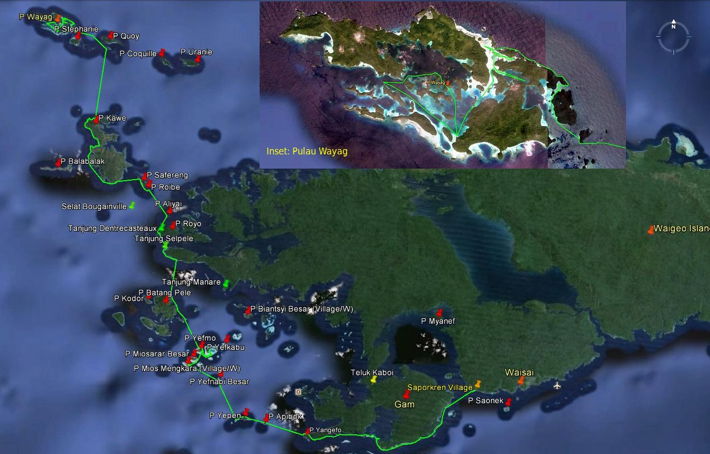
Thanks again go to Alexander Vogel (Walkabout Alex) he completed a round trip to Wayag in 2013, his knowledge and advice was invaluable, Tertius Kammeyer for all his help and assistance especially with sourcing another boat for the transfer to Wayag and lastly our hosts at Mando’s Homestay for their warmth and generous hospitality.
Distance: 200 – 250kms
Paddle Days: 11
Expedition Cost: $3000.00
(Inclusive of kayak hire, transfers, homestay accommodation x 2 nights, all meals)
Airfares: $1500 (Return, Garuda and Virgin Australia to Albany)
Accommodation and Sundries: $400.00 (Not included in expedition costs)
About the author:
Adrian lives in Albany, he has been paddling on and off over the years and joined the Sea Kayak Club in 2011. Previous expeditions have included the Gulf of Thailand, Koh Chang Islands Group and Raja Ampat in 2013. He prefers to paddle solo for solitude or with 2 to 3 other paddlers.
© Adrian Gawned 2014

